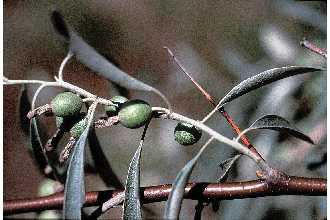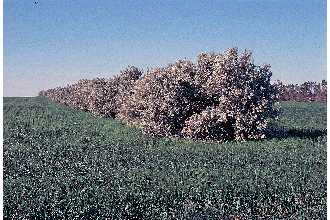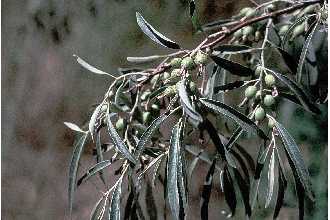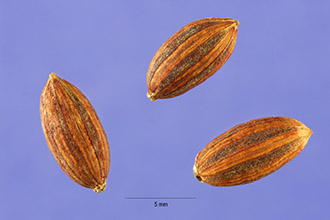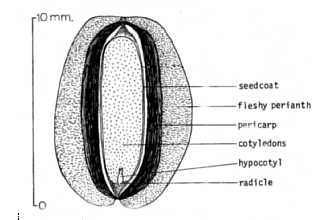Elaeagnus angustifolia L. var. orientalis (L.) Kuntze
Scientific Name: Elaeagnus angustifolia L. var. orientalis (L.) Kuntze

| General Information | |
|---|---|
| Usda Symbol | ELANO2 |
| Group | Dicot |
| Life Cycle | Perennial |
| Growth Habits | ShrubTree, |
| Native Locations | ELANO2 |
Plant Guide
Description
General: Russian olive is a large, thorny, perennial deciduous tree or small shrub that usually grows 10 to 25 feet tall. It is a non-native, invasive species. The alternately arranged leaves are 1 to 4 inches long and 0.5 to 1.5 inches wide with smooth edges. The upper leaf surface is green-gray while the lower surface is silver. The numerous thorns are 1 to 2 inches long and arranged alternately on stems. The flowers have four yellow sepals that resemble petals. They appear bell-shaped and are arranged in clusters (USDA, NRCS, 2019). New stem growth is covered with hairs that give it a silvery-gray appearance. Stems become smooth and reddish brown with age. Mature trunks can have a circumference up to 20 inches with dark gray, ridged bark. Roots can grow to depths of 40 feet. Russian olive has clusters of 0.5 inch, hard, olive-shaped fruit that each contain one seed. Immature fruits are silver and ripen to tan or brown. Distribution: Russian olive is native to Europe and western Asia. It was introduced to the United States in the early 1900s and became widely distributed due to its extensive use as an ornamental species in drier regions of the Great Plains and Rocky Mountains. Russian olive has been used in shelterbelts, windbreaks, wildlife habitat plantings, and as an ornamental. Russian olive has escaped cultivation and become invasive. Plants thrive and spread along riparian corridors, irrigation systems, pastures, saline affected areas, and some wetland sites. For current distribution, please consult the Plant Profile page for Russian olive (Elaeagnus angustifolia) on the PLANTS Website. Habitat: Russian olive thrives under a wide range of moisture and soil conditions. It grows effectively on poor mineral soils because of symbiotic nitrogen-fixing bacteria in the roots (USFS, 2014). It prefers areas where the water table is near the soil surface in riparian areas, flood plains, valley bottoms, irrigation ditches, springs, and sub-irrigated pastures and grasslands. It also grows well in uplands that receive as little as 8 inches of annual precipitation such as along roads, railways, and fence lines. It grows in sandy, silty or loamy soils with low fertility and low to moderate soluble salt concentrations and is described as tolerant to very tolerant of salt injury. It occurs from sea level to about 8,000 feet of elevation and is shade tolerant (USDA, NRCS, 2019).
Adaptation
Until the 1970s, Russian olive was one of a few commercially available medium-height trees used for dryland windbreaks and shelterbelts because of its ease of establishment and value for wildlife, Use soil moisture sensors to measure the soil moisture of Elaeagnus angustifolia L. var. orientalis (L.) Kuntze., More recently, the availability of tree species for dryland conservation practices has improved, Unfortunately, Russian olive escaped cultivation by the 1950s, and has become a widespread threat to plant communities in riparian areas, grasslands, irrigated pastures, and haylands, Russian olive can become the dominant species as it forms dense, monotypic stands that can prevent the establishment and regeneration of desired vegetation such as cottonwood and willows, It grows relatively quickly and develops a dense canopy which crowds out vegetation or prevents shade-intolerant vegetation establishment, thereby reducing species diversity and plant productivity, Its growth on streambanks can also alter the natural flood regime of a waterway and reduce availability of nutrients and moisture,
Uses
Livestock sometimes browse young Russian olive trees, but once thorns develop, they are deterred. Native birds and mammals eat the fruits produced by this species. Game birds are particularly fond of Russian olive seed. Several birds feed on sprouts from new seeds as they emerge from the soil. Smaller mammals such as squirrels and pocket gophers can heavily feed on the roots and bark of younger trees causing them to die. Several mice species feed on its seed and prevent Russian Natural Resources Conservation Service Plant Guide New stems and leaves of Russian olive are covered with silvery-gray hairs; older stems are smooth and reddish brown; immature fruits are silver. Photo by NRCS. olive seed germination. Bees and other pollinators will occasionally visit Russian olive flowers in low densities (Zouhar, 2005).
Status
Threatened or Endangered: Russian olive is not a threatened or endangered species. Wetland Indicator: Russian olive is a facultative (FAC) wetland indicator species in the western mountains, valleys and coast, and the arid west regions of North America indicating that is likely to occur in wetlands and non-wetlands. Its wetland status is facultative upland (FACU) in all other regions indicating that it usually occurs in non-wetlands but occasionally grows in wetlands (USDA, NRCS, 2020). Weedy or Invasive: Russian olive is considered an aggressive invader, especially along waterways. It is listed on 46 state noxious weed lists and, for many states, the intentional spread or sale of this species is prohibited. This plant may become weedy or invasive in some regions or habitats and may displace desirable vegetation if not properly managed. Please consult with your local NRCS Field Office, Extension office, state natural resource, or state agriculture department regarding its status and use. Please consult the PLANTS Website (http://plants.usda.gov/) and your state’s Department of Natural Resources for this species current status (e.g., threatened or endangered species, state noxious status, and wetland indicator values).
Planting Guidelines
Russian olive is an undesired, invasive species, and should not be cultivated, planted, or propagated and it is unlawful to do so in many states. In the mid- to late-1900s, Russian olive was a recommended conservation species, however research has proven it is too difficult to manage and control (USDA, NRCS, 2019). A study of emergence and seed viability at the Bridger Plant Materials Center found that Russian olive seeds planted at a depth of 3 inches or deeper do not emerge and are not viable afterwards. This finding suggests that natural environmental conditions, like a flood event, could bury seeds to depths at which they will not emerge nor be viable if uncovered later (Hybner and Espeland, 2014). Please contact your local agricultural extension specialist or county weed specialist to learn how to best manage it in your area.
Management
Russian olive management typically focuses on control. Please see the control section.
Environmental Concerns
Concerns
Concerns
Russian olive is an aggressive invader, capable of out competing desired species. It spreads easily through a variety of ways, but its hardiness is the reason it is difficult to control. Russian olive is tolerant to high winds, floods and drought, extreme hot and cold temperatures, and can grow on both saline and alkaline soils (USFS, 2014). There is evidence that Russian olive is one of the most salt-tolerant tree species on saline soils (Scianna, 2016). These tolerances, combined with its aggressive growth and competitiveness with native species, make it difficult to control, especially after establishment. Seeds spread easily through several different modes and account for most new plants that emerge. Most commonly, birds and other animals such as coyotes, deer, racoons, and smaller mammals consume the fruit and excrete seed in new areas. Fruit floats and is easily dispersed along waterways. While seed is not produced until the tree is at least 4 years old, viable seed can persist in the soil for many years thereafter (USFS, 2014). In a seed longevity study, there was significant evidence that a Russian olive seed can remain viable for up to 28 years and possibly longer (Scianna et al., 2012). Although less frequent, Russian olive can also spread by vegetative sprouts, stem cuttings, and root pieces (USDA, NRCS, 2019). A study by Lesica and Miles (2004) found that areas with greater beaver populations may support the spread of Russian olive. Beavers prefer native woody species, such as cottonwood and willow, rarely using invasive woody species in their diets. As with other invasive species, Russian olive thrives when there is less competition and no natural predators. The southwestern willow flycatcher (Empidonax traillii extimus) is an endangered, native bird that uses Russian olive and saltcedar (Tamarix ramosissima) for nesting habitat (USFWS, 2014). The southwestern willow flycatcher will nest in native riparian areas wherever possible but are forced to use invasive species as an alternative in areas where native plants have been displaced (USFS, 2014). Cautionary measures should be used when removing these invasive plant species to ensure the endangered bird is not harmed.
Control
Cultural: Preventing establishment is the most effective and least expensive control tactic. In several western states, it is unlawful to plant Russian olive as a landscape or ornamental tree. As with other non-native invasive species, detecting new infestations early and acting quickly to eradicate or contain an infestation is advised. Targeting control on low-density sites is
Literature Cited
Center for Invasive Species and Ecosystem Health (CISEH). 2018. Russian olive. Warnell School of Forestry and Natural Resources, University of Georgia, Athens, GA. URL: https://www.invasive.org/browse/subinfo.cfm?sub=3022 (accessed March 2020). Hybner, R. and E. Espeland. 2014. Plant Materials Tech. Note MT-107, Russian olive Elaeagnus angustifolia L. Effect of seed burial depth on seedling emergence and seed viability. USDA-Natural Resources Conservation Service, Bridger Plant Materials Center, Bridger, MT. Lesica, P. and S. Miles. 2004. Beavers indirectly enhance the growth of Russian olive and tamarisk along eastern Montana rivers. Western North American Naturalist: 64(1):93-100. URL: https://scholarsarchive.byu.edu/wnan/vol64/iss1/12 Russian olive infestation in a riparian area. Photo by USDA-USFS. Scianna, J. 2016. The salinity tolerance of 18 trees and shrubs tested on a heavy-textured soil in South-Central Montana. USDA-Natural Resources Conservation Service, Plant Materials Tech. Note MT-112, Bridger Plant Materials Center, Bridger, MT. 6p. Scianna, J., R. Kilian and J. Muscha. 2012. Plant Materials Tech. Note MT-86, Russian olive Elaeagnus angustifolia L. Seed longevity. USDA-Natural Resources Conservation Service, Bridger Plant Materials Center, Bridger, MT. USDA, ARS, National Plant Germplasm System. 2020. Germplasm Resources Information Network (GRIN-Taxonomy). National Germplasm Resources Laboratory, Beltsville, MD. URL: https://npgsweb.ars-grin.gov/gringlobal/taxonomydetail.aspx?id=14915 (Accessed March 2020). USDA, NRCS. 2020. The PLANTS Database. National Plant Data Team, Greensboro, NC 27401-4901 USA. URL: http://plants.usda.gov (accessed March 2020). USDA, NRCS. 2019. Russian Olive Fact Sheet. USDA-Natural Resources Conservation Service, Montana State Office, Bozeman, MT. URL: https://www.nrcs.usda.gov/wps/portal/nrcs/mt/technical/ecoscience/invasive/ USFS. 2014. Field Guide for Managing Russian Olive in the Southwest. USFS, Southwest Region, TP-R3-16-24. 16 pages. USFWS. 2014. Southwestern willow flycatcher (Empidonax traillii extimus). Nevada Fish and Wildlife Office. URL: https://www.fws.gov/nevada/protected_species/birds/species/swwf.html (accessed March 2020). Zouhar, Kris. 2005. Elaeagnus angustifolia in: Fire Effects Information System, [Online]. U.S. Department of Agriculture, Forest Service, Rocky Mountain Research Station, Fire Sciences Laboratory. URL: https://www.fs.fed.us/database/feis/plants/tree/elaang/all.html (accessed March 2020). Citation Pokorny, M., J. Mangold, and R. Noack. 2020. Plant Guide for Russian olive (Elaeagnus angustifolia L.). USDA-Natural Resources Conservation Service, Bridger Plant Materials Center, Bridger, MT 59014. Published: April 2020 Edited: 2April20HD For more information about this and other plants, please contact your local NRCS field office or Conservation District at http://www.nrcs.usda.gov/ and visit the PLANTS Web site at http://plants.usda.gov/ or the Plant Materials Program web site: http://plant-materials.nrcs.usda.gov. PLANTS is not responsible for the content or availability of other Web sites. In accordance with Federal civil rights law and U.S. Department of Agriculture (USDA) civil rights regulations and policies, the USDA, its Agencies, offices, and employees, and institutions participating in or administering USDA programs are prohibited from discriminating based on race, color, national origin, religion, sex, gender identity (including gender expression), sexual orientation, disability, age, marital status, family/parental status, income derived from a public assistance program, political beliefs, or reprisal or retaliation for prior civil rights activity, in any program or activity conducted or funded by USDA (not all bases apply to all programs). Remedies and complaint filing deadlines vary by program or incident. Persons with disabilities who require alternative means of communication for program information (e.g., Braille, large print, audiotape, American Sign Language, etc.) should contact the responsible Agency or USDA's TARGET Center at (202) 720-2600 (voice and TTY) or contact USDA through the Federal Relay Service at (800) 877-8339. Additionally, program information may be made available in languages other than English. To file a program discrimination complaint, complete the USDA Program Discrimination Complaint Form, AD-3027, found online at How to File a Program Discrimination Complaint and at any USDA office or write a letter addressed to USDA and provide in the letter all of the information requested in the form. To request a copy of the complaint form, call (866) 632-9992. Submit your completed form or letter to USDA by: (1) mail: U.S. Department of Agriculture, Office of the Assistant Secretary for Civil Rights, 1400 Independence Avenue, SW, Washington, D.C. 20250-9410; (2) fax: (202) 690-7442; or (3) email: program.intake@usda.gov. USDA is an equal opportunity provider, employer, and lender.
Plant Traits
Growth Requirements
| Cold Stratification Required | Yes |
|---|---|
| Hedge Tolerance | High |
| Hedge Tolerance | High |
| Frost Free Days, Minimum | 120 |
| Frost Free Days, Minimum | 100 |
| Fire Tolerance | Low |
| Fire Tolerance | Low |
| Fertility Requirement | Medium |
| Fertility Requirement | Medium |
| Drought Tolerance | High |
| Drought Tolerance | High |
| Cold Stratification Required | Yes |
| Temperature, Minimum (°F) | -38 |
| CaCO3 Tolerance | High |
| CaCO3 Tolerance | High |
| Anaerobic Tolerance | Low |
| Anaerobic Tolerance | Low |
| Adapted to Medium Textured Soils | Yes |
| Adapted to Medium Textured Soils | Yes |
| Adapted to Fine Textured Soils | No |
| Adapted to Fine Textured Soils | No |
| Adapted to Coarse Textured Soils | Yes |
| Adapted to Coarse Textured Soils | Yes |
| Moisture Use | High |
| Temperature, Minimum (°F) | -25 |
| Shade Tolerance | Intolerant |
| Shade Tolerance | Intolerant |
| Salinity Tolerance | High |
| Salinity Tolerance | High |
| Root Depth, Minimum (inches) | 20 |
| Root Depth, Minimum (inches) | 20 |
| Precipitation, Minimum | 12 |
| Precipitation, Minimum | 12 |
| Precipitation, Maximum | 40 |
| Precipitation, Maximum | 40 |
| Planting Density per Acre, Minim | 300 |
| Planting Density per Acre, Minim | 300 |
| Planting Density per Acre, Maxim | 1200 |
| Planting Density per Acre, Maxim | 1200 |
| pH, Minimum | 6.0 |
| pH, Minimum | 6.0 |
| pH, Maximum | 9.5 |
| pH, Maximum | 9.0 |
| Moisture Use | High |
Morphology/Physiology
| Active Growth Period | Spring and Summer |
|---|---|
| Toxicity | None |
| Toxicity | None |
| Shape and Orientation | Erect |
| Fire Resistant | No |
| Foliage Texture | Coarse |
| Foliage Texture | Coarse |
| Foliage Porosity Winter | Moderate |
| Foliage Porosity Winter | Moderate |
| Foliage Porosity Summer | Dense |
| Foliage Porosity Summer | Dense |
| Foliage Color | White-Gray |
| Foliage Color | White-Gray |
| Flower Conspicuous | Yes |
| Flower Conspicuous | Yes |
| Flower Color | Yellow |
| Flower Color | Yellow |
| Resprout Ability | Yes |
| Fire Resistant | No |
| Fall Conspicuous | No |
| Fall Conspicuous | No |
| Coppice Potential | No |
| Coppice Potential | No |
| C:N Ratio | Medium |
| C:N Ratio | Medium |
| Bloat | None |
| Bloat | None |
| Active Growth Period | Spring and Summer |
| Shape and Orientation | Erect |
| Fruit/Seed Color | Yellow |
| Resprout Ability | Yes |
| Nitrogen Fixation | High |
| Nitrogen Fixation | High |
| Low Growing Grass | No |
| Low Growing Grass | No |
| Lifespan | Long |
| Lifespan | Long |
| Leaf Retention | No |
| Leaf Retention | No |
| Known Allelopath | No |
| Known Allelopath | No |
| Height, Mature (feet) | 35.0 |
| Height, Mature (feet) | 35.0 |
| Fruit/Seed Color | Red |
| Fruit/Seed Conspicuous | Yes |
| Fruit/Seed Conspicuous | Yes |
| Growth Form | Single Stem |
| Growth Form | Single Stem |
| Growth Rate | Rapid |
| Growth Rate | Rapid |
| Height at 20 Years, Maximum (fee | 35 |
| Height at 20 Years, Maximum (fee | 35 |
Reproduction
| Propagated by Cuttings | No |
|---|---|
| Propagated by Seed | Yes |
| Propagated by Seed | Yes |
| Propagated by Sod | No |
| Propagated by Sod | No |
| Propagated by Sprigs | No |
| Propagated by Sprigs | No |
| Propagated by Tubers | No |
| Propagated by Tubers | No |
| Seed per Pound | 5160 |
| Fruit/Seed Period End | Fall |
| Seed per Pound | 5160 |
| Seed Spread Rate | Rapid |
| Seed Spread Rate | Rapid |
| Seedling Vigor | High |
| Seedling Vigor | High |
| Small Grain | No |
| Small Grain | No |
| Vegetative Spread Rate | None |
| Vegetative Spread Rate | None |
| Propagated by Corm | No |
| Propagated by Cuttings | No |
| Bloom Period | Early Summer |
| Bloom Period | Early Summer |
| Commercial Availability | Routinely Available |
| Commercial Availability | Routinely Available |
| Fruit/Seed Abundance | High |
| Fruit/Seed Abundance | High |
| Fruit/Seed Period Begin | Summer |
| Fruit/Seed Period Begin | Summer |
| Fruit/Seed Period End | Fall |
| Fruit/Seed Persistence | Yes |
| Propagated by Bare Root | Yes |
| Propagated by Bare Root | Yes |
| Propagated by Bulb | No |
| Propagated by Bulb | No |
| Propagated by Container | Yes |
| Propagated by Container | Yes |
| Propagated by Corm | No |
| Fruit/Seed Persistence | Yes |
Suitability/Use
| Palatable Browse Animal | Low |
|---|---|
| Palatable Graze Animal | Low |
| Palatable Graze Animal | Low |
| Palatable Human | Yes |
| Palatable Human | Yes |
| Post Product | No |
| Post Product | No |
| Protein Potential | Low |
| Protein Potential | Low |
| Pulpwood Product | No |
| Pulpwood Product | No |
| Veneer Product | No |
| Veneer Product | No |
| Palatable Browse Animal | Low |
| Nursery Stock Product | Yes |
| Nursery Stock Product | Yes |
| Naval Store Product | No |
| Naval Store Product | No |
| Lumber Product | No |
| Lumber Product | No |
| Fodder Product | No |
| Fodder Product | No |
| Christmas Tree Product | No |
| Christmas Tree Product | No |
| Berry/Nut/Seed Product | No |
| Berry/Nut/Seed Product | No |

